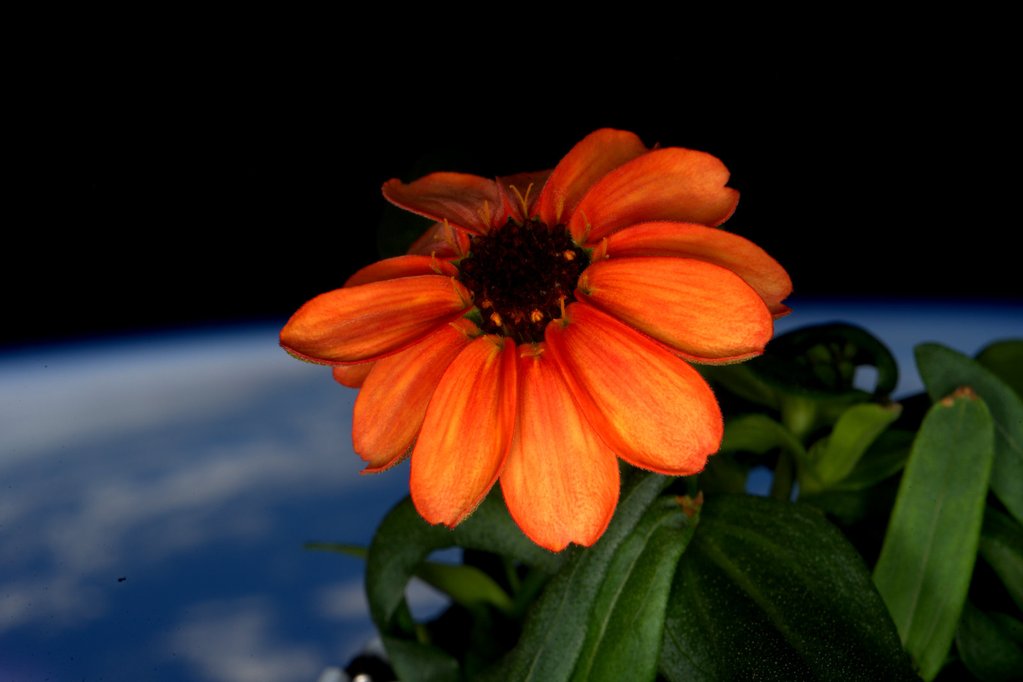A Garden Grows in Space: First Zinnias Bloom, to Astronaut's Delight

Zinnias have opened their pretty petals for the first time on the International Space Station, and NASA astronaut Scott Kelly couldn't be prouder.
The zinnias, grown as part of the Veggie program, have had a rough path: They battled excessive water, overdrying and even enterprising mold before beginning to recover in early January.
To better balance conditions for the zinnias, NASA named Kelly an autonomous gardener (or "commander" of Veggie) on Christmas Eve, so he could independently decide when the plants needed to be watered or tended to instead of waiting for directives from Earth. It looks like that hard work has paid off, with new photos of the zinnia's first vivid orangey-yellow bloom.
Earlier this year, the space station crew grew romaine lettuce (and snacked on it, while their cosmonaut colleagues were on a spacewalk), but the zinnias are a stride forward because they are more challenging to grow, with more exacting environmental requirements.
"The zinnia plant is very different from lettuce," Trent Smith, Veggie project manager, said in a statement. "It is more sensitive to environmental parameters and light characteristics. It has a longer growth duration between 60 and 80 days. Thus, it is a more difficult plant to grow, and allowing it to flower, along with the longer growth duration, makes it a good precursor to a tomato plant."
Many plants have been grown in space — including sunflowers, in 2012 — but the Veggie program aims to learn about how to grow a complicated plant through its entire life cycle and overcome the hurdles on the way.
From …
Get the Space.com Newsletter
Breaking space news, the latest updates on rocket launches, skywatching events and more!
… to …
… to …
Once they conquer zinnias, astronauts might be able to grow other flowering plants, like tomatoes, that could tide astronauts over on long journeys, NASA officials said in the statement.
But for now, the astronauts can come together to marvel at those zinnias growing far from home. Kelly is joined by NASA astronaut Tim Kopra and European Space Agency astronaut Tim Peake, along with cosmonauts Mikhail Kornienko, Sergey Volkov and Yuri Malenchenko. Along with Kornienko, Kelly will end his yearlong stay on the space station in March.
Email Sarah Lewin at slewin@space.com or follow her @SarahExplains. Follow us @Spacedotcom, Facebook and Google+. Original article on Space.com.
Join our Space Forums to keep talking space on the latest missions, night sky and more! And if you have a news tip, correction or comment, let us know at: community@space.com.

Sarah Lewin started writing for Space.com in June of 2015 as a Staff Writer and became Associate Editor in 2019 . Her work has been featured by Scientific American, IEEE Spectrum, Quanta Magazine, Wired, The Scientist, Science Friday and WGBH's Inside NOVA. Sarah has an MA from NYU's Science, Health and Environmental Reporting Program and an AB in mathematics from Brown University. When not writing, reading or thinking about space, Sarah enjoys musical theatre and mathematical papercraft. She is currently Assistant News Editor at Scientific American. You can follow her on Twitter @SarahExplains.









